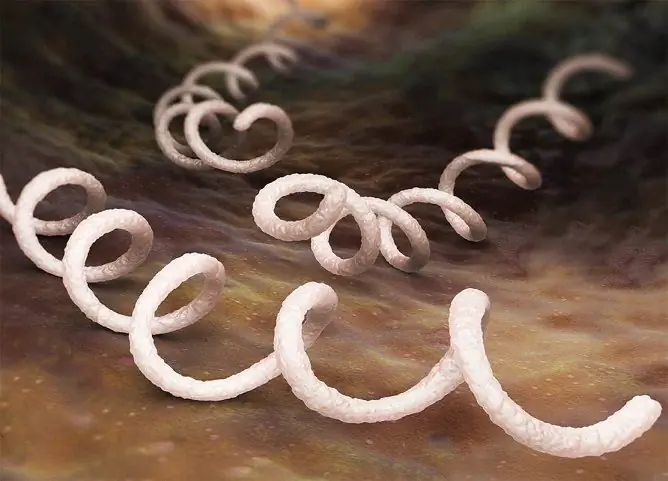- Author Rachel Wainwright [email protected].
- Public 2023-12-15 07:39.
- Last modified 2025-11-02 20:14.
Household syphilis
The content of the article:
- Causes and risk factors
- Forms
- Stages
- Household syphilis symptoms
- Diagnostics
- Treatment
- Possible complications and consequences
- Forecast
- Prevention
Household syphilis is caused by the same pathogen as the genital form of the disease, but the infection does not occur sexually. Although the likelihood of contracting syphilis in everyday life is assessed as low, you should not neglect the precautions, since the dynamics of the pathological process in domestic and genital syphilis does not have significant differences.

The causative agent of syphilis is treponema pale
Causes and risk factors
The causative agent of syphilis is pale treponema (Latin Treponema pallidum), a mobile spiral-shaped gram-negative bacterium. Infection with household syphilis occurs by contact in the presence of damage to the skin and mucous membranes. Contact with patients with primary syphilis is especially dangerous.
The transmission of the pathogen is carried out during direct contact with the patient and when using common objects - dishes, cutlery, towels, toothbrushes, nail scissors, washcloths, combs, bed and underwear, as well as in public hairdressers, toilets and baths. In the presence of syphilitic foci in the oral cavity, the possibility of contracting syphilis during kissing is age. Treponema pallidus easily crosses the placental barrier and is transmitted to the child from an infected mother. There are known cases of infection with syphilis in infants during breastfeeding.

Household syphilis can be transmitted to an infant through breastfeeding
The likelihood of infection increases many times with weakened immunity, living in unsanitary conditions, poverty and overcrowding, caring for patients with syphilis and injection drug addiction.
Forms
Household syphilis proceeds in the same forms as genital syphilis, however, due to the specifics of infection, the localization of the primary signs of the disease is usually not associated with the genitals. In addition to the classic hard chancre, with everyday infection, atypical forms of primary syphilis are not uncommon: chancre-panaritium on the first, second or third finger of the working hand or chancre-amygdalitis on one of the palatine tonsils, not prone to ulceration and erosion. The affected tonsil greatly increases in volume and protrudes into the larynx, causing discomfort and difficulty in swallowing. When the pathogen enters the bloodstream, the primary signs of syphilis may be absent altogether. Congenital syphilis in children infected during intrauterine development is classified into a separate category.
Stages
In the dynamics of domestic syphilis, three stages are distinguished, which differ from each other in the clinical picture and the nature of pathological changes.
- Primary affect. At the site of penetration of the pathogen due to the immune reaction, a characteristic defect is formed - a hard chancre, or syphiloma, which usually resolves itself in the period from 1-2 weeks to 2-3 months. The atypical manifestations of primary syphilis include multiple chancres, indurative edema, chancre-panaritium and chancre-amygdalitis, which occur both on their own and against the background of solid chancre.
- Secondary syphilis. Syphilitic bacteremia develops - a massive release of treponemes into the bloodstream. The first episode resolves itself in 3-4 weeks, after which, over several years, temporary improvements alternate with relapses. During periods of exacerbation, the patient becomes contagious.
- After 2-3 years after infection, secondary syphilis can take the form of neurosyphilis, in which the vessels and membranes of the brain are affected. A typical manifestation of early neurosyphilis is chronic syphilitic meningitis; less commonly diagnosed syphilitic neuritis and polyneuritis, meningovascular syphilis and syphilitic meningoencephalitis.
- Tertiary syphilis - multiple lesions of integumentary tissues, bones, blood vessels, internal parenchymal organs and systems that occur in 30% of patients after several years of latent syphilis.

Stages of household syphilis
Household syphilis symptoms
The clinical picture of domestic syphilis depends on the stage of the disease and the location of the infection. Primary syphiloma looks like a deep, painless ulcer with a diameter of 2 to 20 mm with dense, smooth, rounded edges; in the event of injury to the focus or the addition of a bacterial infection, the bottom may bleed and look loosened. With concomitant unilateral regional lymphadenitis or lymphagnitis, the skin over the lymph node maintains a normal temperature and color, the node is painless on palpation.
At the stage of bacteremia, signs of common syphilis are characterized by significant polymorphism. One of the characteristic features of secondary syphilis is a pale pink rash - flat, rounded papules ranging in size from 3 to 5 mm with a detachable stratum corneum, which forms a recognizable rim on the periphery. Occasionally, pus-filled blisters and pustules form.

A rash with common syphilis most often does not affect the genitals
The rash on the palms and soles of the feet becomes brownish; skin cracks and dense edema may be present. With secondary common syphilis, skin rashes are not prone to fusion; in the case of generalized damage to the lymph nodes, signs of inflammation are still not detected. If the disease proceeds as a catarrh of the upper respiratory tract, there are signs of a cold: runny nose, cough, headaches and sore throat, general weakness and low-grade fever.
Optional symptoms of secondary domestic syphilis can be pigmentation disorders, baldness, hoarseness, skin irritation in the corners of the mouth, etc. Tertiary household syphilis is easily recognized by the presence of multiple gum - soft disintegrating connective tissue formations.
Diagnostics
A preliminary diagnosis of domestic syphilis is made by a dermatovenerologist based on the identification of specific defects in the skin and mucous membranes, localized not in the genital area. Unilateral enlargement of regional lymph nodes without signs of acute inflammation gives even more grounds to suspect syphilis.
To confirm the diagnosis and recognition of latent syphilis, blood tests, cerebrospinal fluid, ulcerative discharge and a biopsy of regional lymph nodes are prescribed. Depending on the methods used, several types of research are distinguished:
- direct and indirect;
- treponemal and non-treponemal;
- screening and confirmatory.
Direct treponemal methods for diagnosing syphilis are not widely used due to their high cost and a number of limitations. In mass screening examinations, inexpensive indirect methods of serological diagnostics are used, based on the detection of antibodies to the causative agent of syphilis - the microprecipitation reaction (RMP) with a cardiolipin antigen and a rapid test for plasma reagins (RPR).

To identify the causative agent of domestic syphilis, blood tests, cerebrospinal fluid and discharge from ulcers are prescribed
It should be borne in mind that the initial stage of primary syphilis is seronegative, therefore, tests must be taken twice with an interval of 2-3 weeks. In addition, the lack of specificity of non-treponemal antigens often causes false positives. The following factors increase the likelihood of an unreliable serodiagnostic result:
- infectious diseases;
- allergic and autoimmune conditions;
- systemic connective tissue pathologies;
- post-vaccination period;
- dermatoses;
- endocrine disorders;
- chronic diseases of the cardiovascular system, lungs, liver and biliary tract;
- acute myocardial infarction;
- pregnancy;
- menstruation;
- elderly age;
- addiction;
- malignant neoplasms;
- endemic treponematoses.
In controversial cases, as well as when examining persons with a high probability of unreliable results of screening samples, tests with a treponemal antigen are performed in order to exclude false positive results:
- immunochemiluminescence (ICL);
- immunochromatography (IHG);
- enzyme immunoassay (ELISA) and immunoblotting;
- immunofluorescence reaction (RIF);
- passive hemagglutination reactions (RPHA).
The reliability of the above methods reaches 70-100%. False positive results are usually explained by the simultaneous presence of other types of spirochetes in the body. For the purpose of differential diagnosis of syphilis, a reaction of immobilization of pale treponemas is carried out, however, in most cases, a combination of a cardiolipin test and an enzyme immunoassay is sufficient. When confirming the diagnosis, all people who have been in contact with the patient must undergo an examination by a dermatovenerologist.
Treatment
For the treatment of domestic syphilis of the primary and secondary stages, as a rule, intramuscular injections of penicillin antibiotics with a weekly interval are sufficient. If there are contraindications to the use of penicillin, it is possible to use erythromycin, cephalosporins and tetracycline derivatives. For the treatment of common tertiary syphilis, with a satisfactory condition of the patient, it is allowed to add arsenic and bismuth compounds to antibacterial drugs.

Intramuscular injections of antibiotics are indicated for the treatment of primary and secondary syphilis
When treating neurosyphilis, intramuscular injections are recommended to be supplemented with endolumbar administration of antibiotics and pyrotherapy. In special cases, it is advisable to use antibacterial agents that overcome the blood-brain barrier.
Possible complications and consequences
Complications of common syphilis usually appear in the tertiary stage of the disease, which is rare. After the transfer of tertiary syphilis, the patient's face and body are disfigured by fibrous scars, and pathological bone mineralization causes irreversible changes in the musculoskeletal system.
There are several types of tertiary syphilis: syphilitic endarteritis and aortitis, late syphilis of bones and muscles, late visceral syphilis with predominant heart damage, etc. The manifestations of late neurosyphilis are especially dangerous: progressive paralysis, optic nerve atrophy, dorsal tabes and taboparalysis (combination of progressive and dorsal tabes).
Brain damage in late neurosyphilis leads to paralysis, paresis, psychotic conditions, seizures and dementia. Atrophy of the optic nerve threatens the patient with blindness, and damage to the spinal nerves and posterior columns of the spinal cord entails a loss of muscular-articular sense and a violation of gait due to sensitive ataxia. In the case of inflammation of large and medium-sized cerebral vessels in meningovascular neurosyphilis, cerebral circulation disorders develop and the risk of ischemic stroke increases.
Forecast
Primary and secondary syphilis in most cases is completely cured by modern drugs. With a long chronic course of the disease and congenital syphilis, pathological changes become irreversible and often lead to disability.
Prevention
Treponema pale is sensitive to high temperatures, the action of alkalis, acids and antiseptic solutions. Compliance with personal hygiene rules, regular cleaning of premises and sanitization of common items minimizes the likelihood of contracting common syphilis. You should not use other people's dishes and toiletries, try on bathing suits and underwear on your naked body, visit public catering establishments and public places with obvious signs of sanitary problems. When visiting beauty salons, hairdressers and dental offices, you need to make sure that the instruments are disinfected.
YouTube video related to the article:

Anna Kozlova Medical journalist About the author
Education: Rostov State Medical University, specialty "General Medicine".
The information is generalized and provided for informational purposes only. At the first sign of illness, see your doctor. Self-medication is hazardous to health!






